I am trying to plot two variables with different ranges using split violinplots in seaborn.
Here's what I have done so far:
from matplotlib import pyplot as plt
import seaborn as sns
import numpy as np
df1 = pd.read_csv('dummy_metric1.csv')
df2 = pd.read_csv('dummy_metric2.csv')
fig, ax2 = plt.subplots()
sns.set_style('white')
palette1 = 'Set2'
palette2 = 'Set1'
colors_list = ['#78C850', '#F08030', '#6890F0', '#A8B820', '#F8D030', '#E0C068', '#C03028', '#F85888', '#98D8D8']
ax1 = sns.violinplot(y=df1.Value,x=df1.modality,hue=df1.metric, palette=palette1, inner="stick")
xlim = ax1.get_xlim()
ylim = ax1.get_ylim()
for violin in ax1.collections:
bbox = violin.get_paths()[0].get_extents()
x0, y0, width, height = bbox.bounds
violin.set_clip_path(plt.Rectangle((x0, y0), width / 2, height, transform=ax1.transData))
ax1.set_xlim(xlim)
ax1.set_ylim(ylim)
ax1.set_title("dummy")
ax1.set_ylabel("metric1")
ax1.set_xlabel("Modality")
ax1.set_xticklabels(ax1.get_xticklabels(), rotation=45, ha='right')
ax1.legend_.remove()
ax2 = ax1.twinx()
ax2 = sns.violinplot(y=df2.Value,x=df2.modality,hue=df2.metric, palette=palette2, inner=None)
xlim = ax2.get_xlim()
ylim = ax2.get_ylim()
for violin in ax2.collections:
bbox = violin.get_paths()[0].get_extents()
x0, y0, width, height = bbox.bounds
violin.set_clip_path(plt.Rectangle((x0, y0), width / 2, height, transform=ax2.transData))
ax2.set_xlim(xlim)
ax2.set_ylim(ylim)
ax2.set_ylabel("Metric2")
ax2.set_xticklabels(ax2.get_xticklabels(), rotation=45, ha='right')
ax2.legend_.remove()
fig.tight_layout()
plt.show()
However, I am unable to use the right portion of the ax2 violins. Here's is the output.
When I do violin.set_clip_path(plt.Rectangle((width/2, y0), width / 2, height, transform=ax2.transData)) I get this result:
Can someone explain what am I missing? Also, how can I manage having inner="stick"?
TIA


